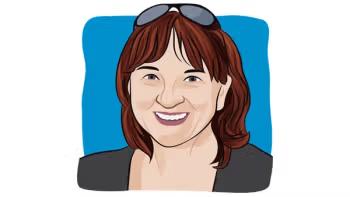
Pinktober: A Whole Family Commemorates the Breast Cancer Experience
Key Takeaways
- The narrative spans four generations, highlighting the hereditary nature of breast cancer and its impact on family dynamics.
- Advances in cancer detection and treatment are underscored, illustrating the evolution of mammography and surgical options over decades.
As someone who disliked pink for years, it has grown on me over time, especially after having breast cancer.
As I remember the cancer journeys of four generations of women in my maternal family, I feel sorrow, as well as joy.
As a child and a much younger adult, I didn’t like the color pink at all. Then, in the 1980s, I had three smart, beautiful and strong daughters. I avoided pink in choosing their clothing, as well as their playthings and other miscellaneous items. Yet, shortly after my youngest was born, I found the color pink starting to grow on me.
Like most of the
My maternal grandmother died of breast cancer the year my oldest daughter was born, but I didn’t consider breast cancer as a hereditary risk quite yet. Grandma had recovered from breast cancer in the World War II era, so I thought of her as a survivor as I grew up. However, when she was in her 70s, the disease recurred and took her life. Soon after, I had a new baby to care for, so I didn’t dwell on the family breast cancer situation.
Then, in the early 90’s, my mother called one day with “news.” She had breast cancer but would be fine. They had caught it early, on a mammogram. But unfortunately, mammograms then were not what they are today. Mom’s cancer soon metastasized, and she suffered through round after round of harsh chemotherapy. At that point, I had to tell my elementary and middle school girls about their grandma’s illness. They didn’t ask about her possible death, and I didn’t bring up the topic. I struggled emotionally; then it was clear that there was a hereditary element to the family cancer. I struggled even more because my mom and I were not close.
After 2 1/2 years of cancer and chemotherapy taking its toll on her body, my mom made what I considered a wise decision. She decided to forego further treatment and let nature take its course. My mother’s home was 275 miles from mine, and after her decision, I traveled back and forth across the state multiple times, just to be there for her. My daughters came with me once,and they understood the significance of seeing their grandma, if only for one more time. My mom and I felt rewarded by the special time alone, and together, and I was able to be with her when she passed away peacefully in her sleep. All of our differences were not magically resolved, but I felt joy and peace soon after the sadness was minimized.
In close to 10 years, I’m sure, the quality of mammograms had improved, and I had not missed my annual breast exam since my mother’s cancer experience. Each annual visit brought with it a lot of anxiety, no more or less than when I visited my imaging center in the spring of 2001. The test seemed fine, but I was called back for a follow-up ultrasound, which showed that I likely had ductal carcinoma in situ (DCIS; stage 0 breast cancer confined to the milk ducts).
At the Race for the Cure that year, my sixth year of participation in the Mother’s Day event, I was in the process of a final diagnosis. My emotions ranged from: Is this exactly where I belong? or will I be wearing the survivor shirt next year? To: I just want to deny it all.
Soon after the Komen Run/Walk I was officially diagnosed. I had DCIS, and I found myself telling my daughters. By then, they were high school and college-aged. It was much the same thing my mother had told me, “It was caught on the mammogram… I will be fine.” How could I expect them to believe me? I was having a hard time believing in myself. However, my daughters were encouraging and supportive of me. One morning, I went downstairs into our kitchen and found several small posters on the walls with optimistic messages, they helped me keep my spirits up.
I met with an excellent breast surgeon, and at our consultation, I told her, “I have a family history of breast cancer, and I’d like to have a bilateral mastectomy and reconstructive surgery. Am I allowed to? Will my insurance company pay for it?”
She immediately told me they would. I had some complications with the reconstruction, but the breast surgery was completely successful, and I was wearing bright pink, and being honored with gifts, a special breakfast and an uplifting song, as we, the breast cancer survivors, stood in front of the stage at the 2002 Komen Race for the Cure.
Years went by and my daughters became adults. They got married and each did well in her chosen careers. Then along came the grandchildren: two boys and two girls. A fifth grandchild is now on the way. I’m so blessed to have good relationships with each of my daughters, most recently, the four of us have started a Zoom book club. Life has been busy, but good.
More time passed, and although not breast cancer, I was revisited by cancer, and this cancer was life-threatening. In the spring of 2018, incidental findings on CT scans showed what appeared to be malignant tumors on each of my lungs. Biopsies confirmed lung cancer. I had completed surgery and chemotherapy.
Facing radiation, then immunotherapy, I got a call from my oldest daughter. “Mom, I have ductal cancer.”
She had the same breast cancer diagnosis I had; she planned to have the same treatment: a mastectomy and reconstruction. Yet she and her family live 225 miles from me. As a mother, I also ruminated, I have to get well as soon as possible, so I can be with my daughter and her family.
I traveled back and forth to help her. Although my daughter’s initial treatment seemed successful, further testing revealed that her breast cancer had spread out of the milk duct and into her breast tissue. She needed chemotherapy and radiation. She suffered a couple of more setbacks but did complete treatment, and is fine now.
Last October, my two younger daughters had flowers sent to my older daughter and me to commemorate the special month, designated for Pinktober. I now buy and wear the color pink fondly, and as I do so I commemorate some of the highest and lowest points in my cancer journey, from 1980 to today. Pinktober, and the pink ribbons that come with it, have always been a part of life for me: whether I’m noticing the implants that are my breasts, or drinking tea from the mug that’s covered in pink ribbons, surrounding the message, “She Who Survived.”
My second cancer, and with it the Lung Cancer white ribbon, led me to dedicate many volunteer hours to those who have and are experiencing their cancer journeys. I’ve met incredible people and learned to love others more than I otherwise may have. Then, early this year, my oldest daughter accepted a new position putting her journalism skills to use, while giving back to the breast cancer community. I AM SO PROUD!
For more news on cancer updates, research and education, don’t forget to




